


Brinjal is one of the most common tropical vegetables grown in India. A large number of cultivars differing in size, shape, and colour of fruits are grown in India. Immature fruits are used in curries, and varieties of dishes are prepared out of brinjal. Fruits are moderate sources of vitamins and minerals like phosphorus, calcium, and iron, and nutritive value varies from variety to variety.
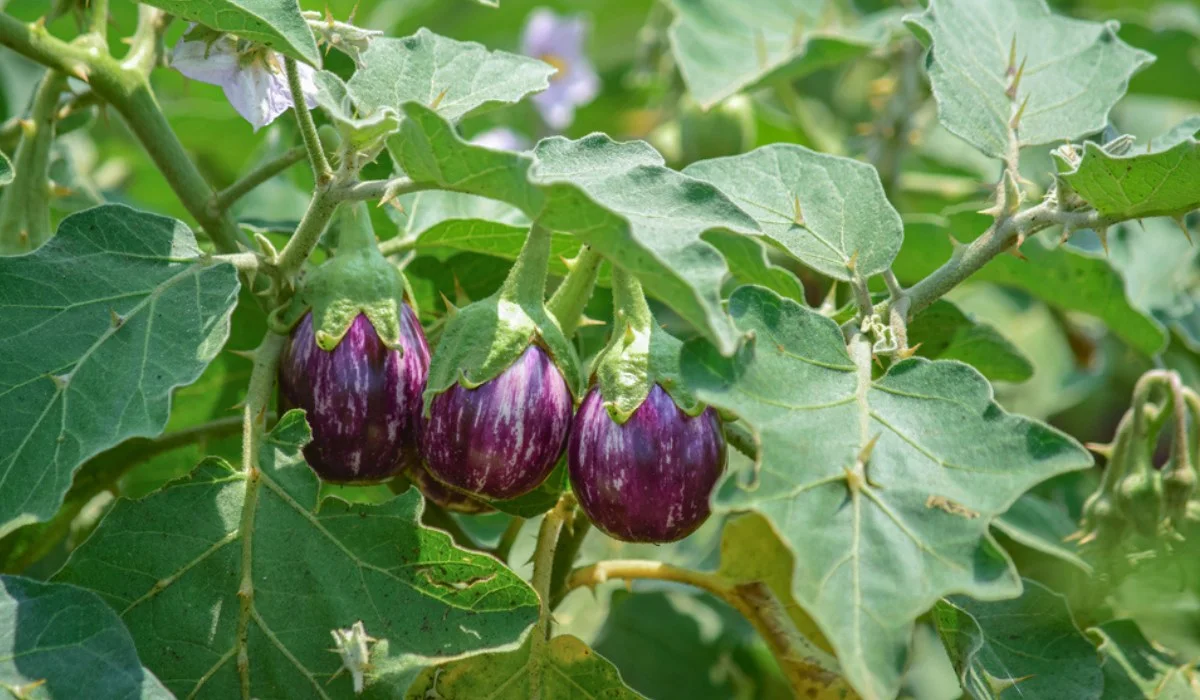

Brinjal is primarily consumed as a cooked vegetable in various ways, while its dried shoots are a source of fuel in rural areas. It is low in calories and fats, contains mostly water, some protein, fibre and carbohydrates. Additionally, it is a good source of minerals, vitamins and rich in water soluble sugars and amide proteins.
| Nutrient | Amount | Unit |
|---|---|---|
| Calories | 24.0 | - |
| Sodium | 3.0 | mg |
| Moisture content | 92.7 | % |
| Copper | 0.12 | mg |
| Carbohydrates | 4.0 | % |
| Potassium | 2.0 | mg |
| Protein | 1.4 | g |
| Sulphur | 44.0 | mg |
| Fat | 0.3 | g |
| Chlorine | 52.0 | mg |
| Fiber | 1.3 | g |
| Vitamin A | 124.0 | I.U. |
| Oxalic acid | 18.0 | mg |
| Folic Acid | 34.0 | µg |
| Calcium | 18.0 | mg |
| Thiamine | 0.04 | mg |
| Magnesium | 15.0 | mg |
| Riboflavin | 0.11 | mg |
| Phosphorus | 47.0 | mg |
| B-carotene | 0.74 | µg |
| Iron | 0.38 | mg |
| Vitamin C | 12.0 | mg |
| Zinc | 0.22 | mg |
| Amino Acids | 0.22 | - |

In Assam, area of brinjal is 753000 hectares and production is 13023000 MT

Brinjal is a warm season crop and requires a long warm growing season. This makes it very susceptible to frost. A daily mean temperature of 13-21oC is most favourable for its successful production. The growth of the crop is severely affected when temperature falls below 17oC. It can be successfully grown as a rainy and summer season crop with an elevation of 1200 m above sea level.

Well-drained rich sandy loam for early and silt loam to clay loam for late crop. pH 5.5 – 7.0 is ideal.

Pusa Kranti: Dwarf and spreading growth habit, leaf long, narrow and highly lobed, green coloured, non-spiny, fruit are 15-20 cm long, attractive dark purple in colour, less seeded, yield about 270 q/ha.
Pusa Purple Long: Plant semi-erect and dwarf, in habit; fruit glossy, light purple in colour, 25-30 cm long, smooth and tender; av. yield 275 (q/ha), maturity 100-110 days.
Pusa Purple Cluster: Plant tall erect, compact, sturdy with purple pigmentation on stem; leaf purple, non-spiny; fruits born in clusters of 4-8, 10-12 cm long, deep purple colour, av. yield 175 q/ha, maturity 75 days, relatively resistant to bacterial wilt and little leaf disease.
Pusa Purple Round: Plant very tall with thick stem of greenish purple colour, leaf highly lobed with deep green colour; av. weight 137 g with only 6 fruits per plant, resistant to shoot borer and little leaf disease.
Pusa Bhairav: Resistant to phomopsis blight.
BB–7: Fruit oblong, borne in cluster, purple, yield about 200 q/ha, tolerant to bacterial wilt.
BWR–34: Fruit elongated, borne in cluster, purple; yield about 100q/ha, tolerant to bacterial wilt.
Pant Samrat: Resistant to fruit and shoot borer and bacterial wilt. (Recommended for bacterial wilt endemic areas).

The land should be prepared to a fine tilth, and FYM (Farm Yard Manure) should be applied. Clothianidin 50WDG 80 g ai/ha should be incorporated. It is advisable to apply lime every three years at 20 q/ha depending upon soil test result. Liming should be done at least 30 days before planting.
Seed rate is 700-800 g/ha (93-107 g/bigha).
First week of September to October for winter crop and January to February for spring crop.
Recommended spacing is 75 cm x 60 cm (Row to Row and Plant to Plant).
FYM @ 10 t/ha, N 50 kg, P2O5 50 kg, and K2O 50 kg/ha (1.3 t FYM, 14.7 kg Urea, 42.0 kg SSP, 11.3 kg MOP). Half of N and full doses of FYM, P2O5, and K2O should be applied as basal, and the remaining half of N should be top dressed in one or two installments.
FYM 10 t/ha and NPK @ 10:30:15 kg/ha is recommended for the 1st crop of brinjal followed by the 2nd crop of okra without FYM and with the recommended dose of NPK.

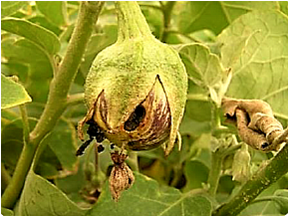
Growing garlic as an intercrop or border crop reduces the infestation.
a) Apply Emmamectin benzoate 5 SG @ 220 g/ha. Flubendiamide 39.35 EC @ 0.1%. Chlorantraniliprole 18.5 SC @ 40 gai/ha.
b) Apply Lamda-cyhalothrin 5EC @ 20 g ai/ha.
Common in coastal environments and sporadically elsewhere, favored by high humidity and temperatures
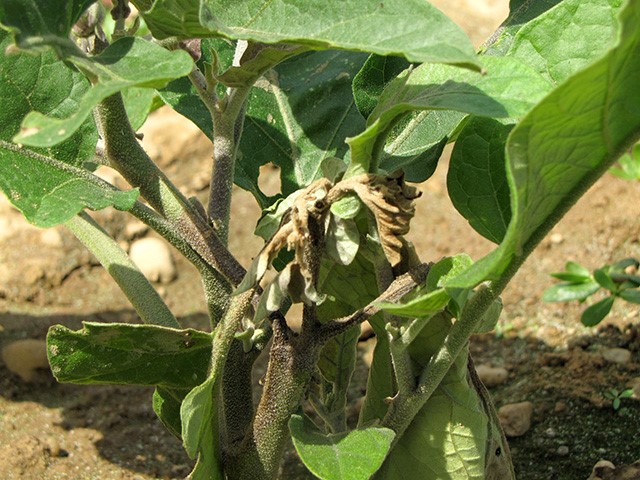
Six sprays with copper oxychloride 50 WP @ 2 g/lit at a 12-day interval.
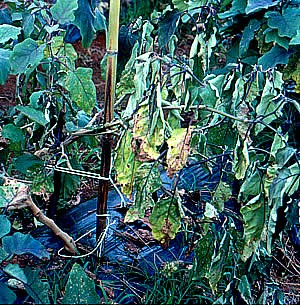
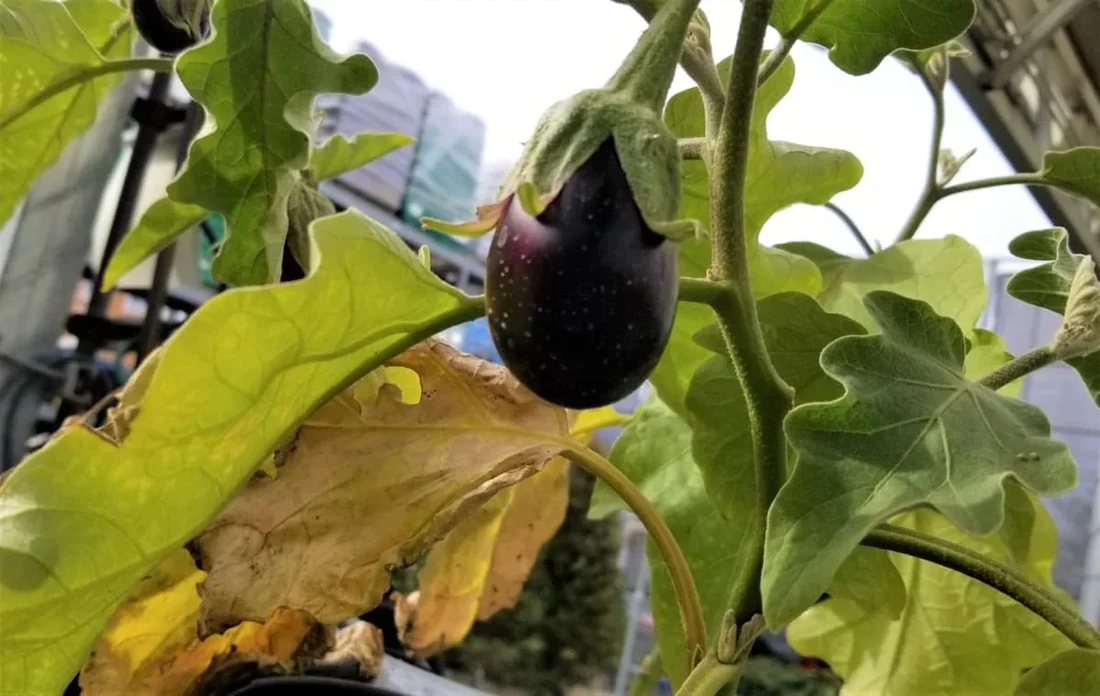
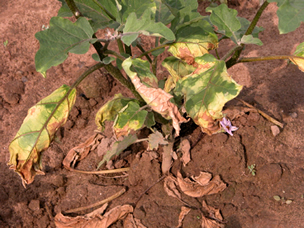

Yield Expectation: 200 q/ha
The matured fruits are ready for picking after 120 – 130 days of seed sowing, depending on the variety. The harvesting of the fruits should be done as soon as it attains a good size and colour. Fruits are harvested when they the colour changes to greenish yellow or bronze and the flesh is dry and tough. Some portion of the calyx and the stem-end is retained on the fruit during harvesting. Since all the fruits do not mature at the same time, the fruits are harvested at an interval of 8-10 days.
Jorhat, PIN - 785013 Assam